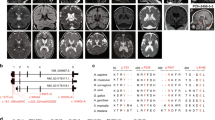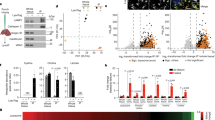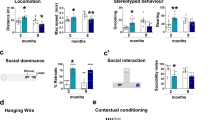Abstract
Niemann–Pick type C (NP-C) disease is a fatal, autosomal recessive, childhood neurodegenerative disease. The NP-C mouse recapitulates the cholesterol and sphingolipid storage, onset of neurological deficits, histopathological lesions, Purkinje cell loss and early death typical of the most severe form of human NP-C. Neurosteroids, steroids made in the brain, affect neuronal growth and differentiation, and modulate neurotransmitter receptors. Disordered cholesterol trafficking might disrupt neurosteroidogenesis, thereby contributing to the NP-C phenotype. Here we show that NP-C mouse brain contains substantially less neurosteroid than wild-type brain and has an age-related decrease in the ability to synthesize 5α-dihydroprogesterone and allopregnanolone. Immunohistochemical assessment confirms a decrease in expression of 5α-reductase and 3α-hydroxysteroid dehydrogenase, especially in cerebellum. Neonatal administration of allopregnanolone delays the onset of neurological symptoms, increases Purkinje and granule cell survival, reduces cortical GM2 and GM3 ganglioside accumulation and doubles the lifespan of NP-C mice. Earlier administration increases effectiveness of treatment. Decreased production of allopregnanolone apparently contributes to the pathology of NP-C; thus, neurosteroid treatment may be useful in ameliorating progression of the disease.
This is a preview of subscription content, access via your institution
Access options
Subscribe to this journal
Receive 12 print issues and online access
$209.00 per year
only $17.42 per issue
Buy this article
- Purchase on Springer Link
- Instant access to full article PDF
Prices may be subject to local taxes which are calculated during checkout






Similar content being viewed by others
References
Patterson, M.C. et al. Niemann-Pick disease type C: a lipid trafficking disorder. in The Metabolic and Molecular Bases of Inherited Disease (eds. Scriver, C.R., Beaudet, A.L., Sly, W.S. & Valle, D.) 3611–3633 (McGraw-Hill, New York, 2001).
Fink, J.K. et al. Clinical spectrum of Niemann-Pick disease type C. Neurology 39, 1040–1049 (1989).
Vanier, M.T. & Millat, G. Niemann-Pick disease type C. Clin. Genet. 64, 269–281 (2003).
Vanier, M.T., Duthel, S., Rodriguez-Lafrasse, C., Pentchev, P. & Carstea, E.D. Genetic heterogeneity in Niemann-Pick C disease: a study using somatic cell hybridization and linkage analysis. Am. J. Hum. Genet. 58, 118–125 (1996).
Naureckiene, S. et al. Identification of HE1 as the second gene of Niemann-Pick C disease. Science 290, 2298–2301 (2000).
Carstea, E.D. et al. Niemann-Pick C1 disease gene: homology to mediators of cholesterol homeostasis. Science 277, 228–231 (1997).
Roff, C.F. et al. Niemann-Pick type-C disease: deficient intracellular transport of exogenously derived cholesterol. Am. J. Med. Genet. 42, 593–598 (1992).
Cruz, J.C. & Chang, T.Y. Fate of endogenously synthesized cholesterol in Niemann-Pick type C1 cells. J. Biol. Chem. 275, 41309–41316 (2000).
Zervas, M., Dobrenis, K. & Walkley, S.U. Neurons in Niemann-Pick disease type C accumulate gangliosides as well as unesterified cholesterol and undergo dendritic and axonal alterations. J. Neuropathol. Exp. Neurol. 60, 49–64 (2001).
Morris, M.D., Bhuvaneswaran, C., Shio, H. & Fowler, S. Lysosome lipid storage disorder in NCTR-BALB/c mice. I. Description of the disease and genetics. Am. J. Pathol. 108, 140–149 (1982).
Loftus, S.K. et al. Murine model of Niemann-Pick C disease: mutation in a cholesterol homeostasis gene. Science 277, 232–235 (1997).
Higashi, Y., Murayama, S., Pentchev, P.G. & Suzuki, K. Cerebellar degeneration in the Niemann-Pick type C mouse. Acta Neuropathol. (Berl.) 85, 175–184 (1993).
Ong, W.Y. et al. Neurodegeneration in Niemann-Pick type C disease mice. Exp. Brain Res. 141, 218–231 (2001).
Vincent, I., Bu, B. & Erickson, R.P. Understanding Niemann-Pick type C disease: a fat problem. Curr. Opin. Neurol. 16, 155–161 (2003).
Xie, C., Burns, D.K., Turley, S.D. & Dietschy, J.M. Cholesterol is sequestered in the brains of mice with Niemann-Pick type C disease but turnover is increased. J. Neuropathol. Exp. Neurol. 59, 1106–1117 (2000).
Xie, C., Lund, E.G., Turley, S.D., Russell, D.W. & Dietschy, J.M. Quantitation of two pathways for cholesterol excretion from the brain in normal mice and mice with neurodegeneration. J. Lipid Res. 44, 1780–1789 (2003).
Braak, H., Braak, E. & Goebel, H.H. Isocortical pathology in type C Niemann-Pick disease. A combined Golgi-pigmentoarchitectonic study. J. Neuropathol. Exp. Neurol. 42, 671–687 (1983).
Suzuki, K. et al. Neurofibrillary tangles in Niemann-Pick disease type C. Acta Neuropathol. (Berl.) 89, 227–238 (1995).
German, D.C. et al. Selective neurodegeneration, without neurofibrillary tangles, in a mouse model of Niemann-Pick C disease. J. Comp. Neurol. 433, 415–425 (2001).
Walkley, S.U., Siegel, D.A., Dobrenis, K. & Zervas, M. GM2 ganglioside as a regulator of pyramidal neuron dendritogenesis. Ann. NY Acad. Sci. 845, 188–199 (1998).
Zervas, M., Somers, K.L., Thrall, M.A. & Walkley, S.U. Critical role for glycosphingolipids in Niemann-Pick disease type C. Curr. Biol. 11, 1283–1287 (2001).
Liu, Y. et al. Alleviation of neuronal ganglioside storage does not improve the clinical course of the Niemann-Pick C disease mouse. Hum. Mol. Genet. 9, 1087–1092 (2000).
Gondre-Lewis, M.C., McGlynn, R. & Walkley, S.U. Cholesterol accumulation in NPC1-deficient neurons is ganglioside dependent. Curr. Biol. 13, 1324–1329 (2003).
Roff, C.F. et al. The murine Niemann-Pick type C lesion affects testosterone production. Endocrinology 133, 2913–2923 (1993).
Compagnone, N.A. & Mellon, S.H. Neurosteroids: biosynthesis and function of these novel neuromodulators. Front. Neuroendocrinol. 21, 1–56 (2000).
Costa, E. & Paul, S.M. Neurosteroids and Brain Function (Thieme Medical Publishers, New York, 1991).
Brinton, R.D. The neurosteroid 3α-hydroxy-5α-pregnan-20-one induces cytoarchitectural regression in cultured fetal hippocampal neurons. J. Neurosci. 14, 2763–2774 (1994).
Brussaard, A.B., Wossink, J., Lodder, J.C. & Kits, K.S. Progesterone-metabolite prevents protein kinase C-dependent modulation of γ-aminobutyric acid type A receptors in oxytocin neurons. Proc. Natl. Acad. Sci. USA 97, 3625–3630 (2000).
Concas, A. et al. Role of brain allopregnanolone in the plasticity of γ-aminobutyric acid type A receptor in rat brain during pregnancy and after delivery. Proc. Natl. Acad. Sci. USA 95, 13284–13289 (1998).
Grobin, A.C., Heenan, E.J., Lieberman, J.A. & Morrow, A.L. Perinatal neurosteroid levels influence GABAergic interneuron localization in adult rat prefrontal cortex. J. Neurosci. 23, 1832–1839 (2003).
Miller, W.L. Molecular biology of steroid hormone synthesis. Endocr. Rev. 9, 295–318 (1988).
Belelli, D. & Gee, K.W. 5α-Pregnan-3α,20α-diol behaves like a partial agonist in the modulation of GABA-stimulated chloride ion uptake by synaptoneurosomes. Eur. J. Pharmacol. 167, 173–176 (1989).
Purdy, R.H., Morrow, A.L., Blinn, J.R. & Paul, S.M. Synthesis, metabolism, and pharmacological activity of 3α-hydroxy steroids which potentiate GABA-receptor-mediated chloride ion uptake in rat cerebral cortical synaptoneurosomes. J. Med. Chem. 33, 1572–1581 (1990).
Prasad, A., Fischer, W.A., Maue, R.A. & Henderson, L.P. Regional and developmental expression of the Npc1 mRNA in the mouse brain. J. Neurochem. 75, 1250–1257 (2000).
Henderson, L.P. et al. Embryonic striatal neurons from Niemann-Pick type C mice exhibit defects in cholesterol metabolism and neurotrophin responsiveness. J. Biol. Chem. 275, 20179–20187 (2000).
Voikar, V., Koks, S., Vasar, E. & Rauvala, H. Strain and gender differences in the behavior of mouse lines commonly used in transgenic studies. Physiol. Behav. 72, 271–281 (2001).
Lambert, J.J., Belelli, D., Peden, D.R., Vardy, A.W. & Peters, J.A. Neurosteroid modulation of GABAA receptors. Prog. Neurobiol. 71, 67–80 (2003).
Lin, D. et al. Role of steroidogenic acute regulatory protein in adrenal and gonadal steroidogenesis. Science 267, 1828–1831 (1995).
Soccio, R.E. & Breslow, J.L. StAR-related lipid transfer (START) proteins: mediators of intracellular lipid metabolism. J. Biol. Chem. 278, 22183–22186 (2003).
Griffin, L.D. & Mellon, S.H. Selective serotonin reuptake inhibitors directly alter activity of neurosteroidogenic enzymes. Proc. Natl. Acad. Sci. USA 96, 13512–13517 (1999).
Griffin, L.D. & Mellon, S.H. Biosynthesis of the neurosteroid 3α-hydroxy-4-pregnen-20-one (3α HP), a specific inhibitor of FSH release. Endocrinology 142, 4617–4622 (2001).
Wiebe, J.P., Boushy, D. & Wolfe, M. Synthesis, metabolism and levels of the neuroactive steroid, 3α-hydroxy-4-pregnen-20-one (3αHP), in rat pituitaries. Brain Res. 764, 158–166 (1997).
Purdy, R.H. et al. Radioimmunoassay of 3α-hydroxy-5α-pregnan-20-one in rat and human plasma. Steroids 55, 290–296 (1990).
Black, S.M. et al. Regulation of proteins in the cholesterol side-chain cleavage system in JEG-3 and Y-1 cells. Endocrinology 132, 539–545 (1993).
Viger, R.S. & Robaire, B. Immunocytochemical localization of 4-ene steroid 5α-reductase type 1 along the rat epididymis during postnatal development. Endocrinology 134, 2298–2306 (1994).
Doody, K.M. et al. 3β-hydroxysteroid dehydrogenase/isomerase in the fetal zone and neocortex of the human fetal adrenal gland. Endocrinology 126, 2487–2492 (1990).
Karl, T., Pabst, R. & von Horsten, S. Behavioral phenotyping of mice in pharmacological and toxicological research. Exp. Toxicol. Pathol. 55, 69–83 (2003).
Basso, D.M., Beattie, M.S. & Bresnahan, J.C. A sensitive and reliable locomotor rating scale for open field testing in rats. J. Neurotrauma 12, 1–21 (1995).
Fujita, N. et al. Targeted disruption of the mouse sphingolipid activator protein gene: a complex phenotype, including severe leukodystrophy and wide-spread storage of multiple sphingolipids. Hum. Mol. Genet. 5, 711–725 (1996).
Kyrklund, T. Two procedures to remove polar contaminants from a crude brain lipid extract by using prepacked reversed-phase columns. Lipids 22, 274–277 (1987).
Acknowledgements
We thank C. Brown, T. Tang and P. Hoang for technical assistance; B. Robaire for antiserum to rat 5α-reductase type 1; W.L. Miller for antiserum to human P450scc; J.I. Mason for antiserum to human 3βHSD; P. Sluss for antiserum to allopregnanolone; and M.T. Vanier, in whose laboratory the lipid analyses were done. This work was supported by the National Institutes of Health (S.H.M. and L.D.G.), National Niemann Pick Disease Foundation (S.H.M. and L.D.G.), March of Dimes Birth Defects Foundation (S.H.M.), Ara Parseghian Medical Research Foundation (S.H.M.) and Vaincre les Maladies Lysosomales (L.V.).
Author information
Authors and Affiliations
Corresponding author
Ethics declarations
Competing interests
The authors declare no competing financial interests.
Rights and permissions
About this article
Cite this article
Griffin, L., Gong, W., Verot, L. et al. Niemann–Pick type C disease involves disrupted neurosteroidogenesis and responds to allopregnanolone. Nat Med 10, 704–711 (2004). https://doi.org/10.1038/nm1073
Received:
Accepted:
Published:
Issue Date:
DOI: https://doi.org/10.1038/nm1073
This article is cited by
-
The cholesterol transporter NPC1 is essential for epigenetic regulation and maturation of oligodendrocyte lineage cells
Nature Communications (2023)
-
Evidence of redox imbalance and mitochondrial dysfunction in Niemann-Pick type C 1 patients: the in vitro effect of combined therapy with antioxidants and β‐cyclodextrin nanoparticles
Metabolic Brain Disease (2023)
-
Expanded access with intravenous hydroxypropyl-β-cyclodextrin to treat children and young adults with Niemann-Pick disease type C1: a case report analysis
Orphanet Journal of Rare Diseases (2019)
-
Allopregnanolone Treatment Improves Plasma Metabolomic Profile Associated with GABA Metabolism in Fragile X-Associated Tremor/Ataxia Syndrome: a Pilot Study
Molecular Neurobiology (2019)
-
Central intracrine DHEA synthesis in ageing-related neuroinflammation and neurodegeneration: therapeutic potential?
Journal of Neuroinflammation (2018)



